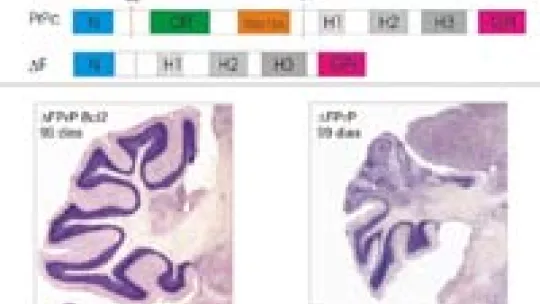Images
The study provides further insight into the functions of the cellular prion protein, a key protein in the central nervous system.
Scientists from the Developmental Neurobiology and Regeneration group at the Institute for Research in Biomedicine (IRB Barcelona) and the Cellular and Molecular Basis in Neurodegeneration and Neurorepair group from the University of Barcelona (UB), have succeeded in slowing down neuronal death in cerebellum of mice that overexpress a truncated form of the cellular prion protein (PrPc). This protein is located in the membrane of neurons and glial cells and is involved in the control of basic nervous system functions, such as neurotransmission or cell proliferation during development and in adult life. Any alteration in this protein has fatal consequences for the life of these nerve cells.
A working group led by José Antonio del Río have worked with mice that lacked the N-terminal fragment of PrPc. This truncated protein induced massive death of cerebellar neurons, severely impairing the mobility and coordination ability of the mice, and leading to their premature death. The researchers were able to analyse the signalling mechanisms involved in neural death induced by this mutated form of the protein and identified the involvement of the p53 protein, a known promoter of cell suicide or apoptosis.
José Antonio del Río and his team have been studying the functions of the cellular prion protein, which is found naturally in the body’s nervous system, for 5 years. “We now need to investigate whether the absence of the N-terminal domain of PrPc allows the truncated protein to participate actively in processes of apoptosis, in other words, whether it is proapoptotic”, explains del Río. Their suspicion is based on the fact that the simple overexpression of complete PrPc protein also induces cell death, and consequently could act as a “switch” that activates a chain of signals leading to cell suicide. Even so, scientists do not yet know which part of PrPc is responsible for controlling these functions. "This type of study helps to improve our understanding of the different functional regions of the protein with the purpose of finding new targets to stop neural death. Our hypothesis is that PrPc plays an important role in maintaining the internal balance of an organism’s cells."
José A. del Río: "PrPC could be a switch that activates a chain of signaling events that ends in cell suicide"
How can neuronal death be stopped?
The next challenge for the team was to stop cerebellar degeneration and premature death in mutant mice. They generated a transgenic animal that did not express PrPc and that overexpressed both the truncated prion protein and the bcl-2 protein, an antiapoptotic agent known to be a neuronal promoter.
The results showed that cerebellar degeneration was slowed down in half the mice. Del Río sees the results as "promising, since we may be able to use the bax/bcl-2 complex as a target to stop neural degeneration in other prion mutations, as a complementary tool to other strategies. Even so, we are happy with our results; this is the first time that we have been able to stop degeneration and premature death in this type of animal model using neuronal promoter to express bcl-2 protein."
"The bax/bcl-2 complex may be a target to halt the degeneration of neurons in other cases of prionic mutation."
PrPc and transmissible spongiform encephalopathies
PrPc is the key to a class of neurodegenerative diseases called transmissible spongiform encephalopathies, which include mad cow disease (bovine spongiform encephalopathy, BSE) and its human variant, Creutzfeld-Jakob´s disease. These diseases are caused by prions (modified PrPc forms), infectious elements that once in the body, can interact with endogenous PrPc, modifying its structure and giving rise to highly toxic protein forms that are resistant to chemical treatment. In this type of prion disease, the infected nerve tissue degenerates, acquiring a structure that, upon microscopic examination, presents numerous cavities similar to those of a sponge, resulting from cell death. At present, prion diseases are untreatable and fatal.
"It is clear –argues Del Río- that the more we understand how the cellular prion protein functions in its natural state, the sooner we will be able to control its ability to infect – whether this is caused by a prion or by mutations in the protein".
The study was conducted with the collaboration of Prof. Adriano Aguzzi from the Institute of Neuropathology at University Hospital Zurich. The results of the study have been recently published in the FASEB Journal, the official journal of the American Society of Experimental Biology.
Reference article:
Bcl-2 overexpression delays caspase-3 activation and rescues cerebellar degeneration in prion-deficient mice that overexpress amino-terminally truncated prion
Oriol Nicolas, Rosalina Gavín, Nathalie Braun, Jesús Mariano Ureña, Xavier Fontana, Eduardo Soriano, Adriano Aguzzi, and José Antonio del Río
FASEB J. 2007 May 10; [Epub ahead of print]
About IRB Barcelona
The Institute for Research in Biomedicine (IRB Barcelona) pursues a society free of disease. To this end, it conducts multidisciplinary research of excellence to cure cancer and other diseases linked to ageing. It establishes technology transfer agreements with the pharmaceutical industry and major hospitals to bring research results closer to society, and organises a range of science outreach activities to engage the public in an open dialogue. IRB Barcelona is an international centre that hosts 400 researchers and more than 30 nationalities. Recognised as a Severo Ochoa Centre of Excellence since 2011, IRB Barcelona is a CERCA centre and member of the Barcelona Institute of Science and Technology (BIST).





